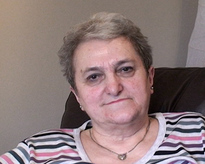Irene - Interview 41

Diagnosed in 1989 at the age of 49 and put on HRT and sandocal. In March 1990 diagnosed with breast cancer and underwent lumpectomy and radiotherapy; HRT discontinued. First DXA scan in 1998. Now on alendronic acid and Adcal D3. Improvement in bone density and now she has osteopenia rather than osteoporosis.
Retired teacher; married with two adult children. In 1994 she joined a new exercise project for osteoporotic patients run by a local hospital in her city. She exercises three times a week.
More about me...
Irene explains how the exercise programme for people with osteoporosis came about and how it has expanded outside the hospital setting.
Irene explains how the exercise programme for people with osteoporosis came about and how it has expanded outside the hospital setting.
Irene said that the exercise programme was like a 'drug trial' study. The physiotherapist compared between patients taking part in the exercise sessions and those who didn't (the placebo).
Irene said that the exercise programme was like a 'drug trial' study. The physiotherapist compared between patients taking part in the exercise sessions and those who didn't (the placebo).
Irene talks about the type of movements included in the exercise programme for people with osteoporosis.
Irene talks about the type of movements included in the exercise programme for people with osteoporosis.
Irene explains how she got involved with her local support group and became responsible for producing their Newsletter.
Irene explains how she got involved with her local support group and became responsible for producing their Newsletter.
Irene's support group organises various activities including talks by local health professionals.
Irene's support group organises various activities including talks by local health professionals.
Well, we meet once a month, the second Thursday each month and we try to have, well, we try to have speakers that are to do with osteoporosis. We try to have a doctor, one of the osteoporosis nurses, a physiotherapist and hopefully a nutritionist is supposed to be there. It doesn’t always work out. We have got, we have several patrons. We have a political patron. We have a physiotherapist, that was the one that started off the exercise as a patron. We have a Glasgow writer as a patron. And we also have a, another clinician as patron. So we can always go to them and say, “Will you please come and give us a talk?” And people come along and say to us, “Oh, I thought you were talking about osteoporosis.
And this is where I come out with this thing again. “But we’re not here to dwell on the fact we have osteoporosis. We’ll talk to you about it. We’ll give you our support. We’ll tell you what we have found.” Because we’ve all been at the stage of being, feeling isolated, feeling, “What on earth has happened to me?” But I think part of the thing is that they describe it as being crumbling bones. And I think the fear of that is you could look at one of these characters in a cartoon where someone raps you over the hand walks away with you in the end because your bones have crumbled into the bottom of your body. And I just say, “Well, that’s not really what it means. It means ‘do something about it’.” Although I must admit it isn’t always possible. People have got a lot of things, and they have osteoporosis come along with other things involved that you think, “Well, okay, you need support, so what can we..?” And part of it is the fact that we can’t, we don’t give medical advice, we’re not medically qualified. But what we can do is say, “Well, if you speak to Dr so-and-so or...” Well, we’re very fortunate, the doctors are very very helpful with us, very helpful and very willing to come and talk to us. And they, I think probably because we are very much involved with the health board as well and we’ve got the support of the health board. And they come along, the nurses are great, they come along and talk to us about, they tell us about different sort of things, all different aspect of things. We’ve had an occupational therapist along to talk to us. Which was good, because it means that we know. It’s especially good if we’ve got a newcomer at the group that doesn’t know anything about it. Most of us are old hands at the group, “I’ve heard this story before.” But it’s good to refresh our memories about things. And it’s especially good if a newcomer comes along that’s totally, “I’ve got osteoporosis. What am I going to do?”
And they find out, “Well, you can sit and enjoy our company. That’s one of the things you can do.” And, well, we try to have other things like, we have, because we live in this city, we try to have something which is related to the city. Because somebody once asked me, when I was chair of the group, “Why are you having this..?” I can’t remember what the thing was. And I said, “Well, it’s because we are in the city and its part of the history of the city and it’s good to find out about it as well.”

